Reading time 7 minutes.
Notre vol Istanbul – Tashkent était à six heures du matin. Nous avons pris le bus Havaist de deux heures du matin depuis la place Taksim pour nous rendre à l’aéroport. La nuit fut courte ! Nous avons passé le premier et le dernier jour de notre séjour de 17 jours en Ouzbékistan à Tashkent.
Jour 1
Les Transports
Le plan de la journée consistait à déposer nos bagages à la gare de train, car nous prenions le train de nuit pour Bukhara, pour ensuite partir visiter la ville. Nous avons retiré beaucoup d’argent à l’aéroport, car nous devions payer tous nos hôtels en liquide. Ce fut l’unique retrait d’argent du séjour. Pour nous rendre de l’aéroport à la gare, nous étions censés prendre le bus 40. Le bus 46 était là, un local et le chauffeur nous ont proposé de monter, et nous avons obtempéré. Au bout de quelques arrêts, nous sommes descendus avec le local qui nous montrait le chemin et avons couru ensemble vers le bus 40. Il nous accompagna ainsi jusqu’à la gare de Tahskent Nord.
En utilisant l’application Yandex Go, nous aurions pu prendre un taxi pour 1.5-3 euros. Les transports en commun coûtent environ 0.10 euro par trajet et peuvent être payés avec une carte bancaire.
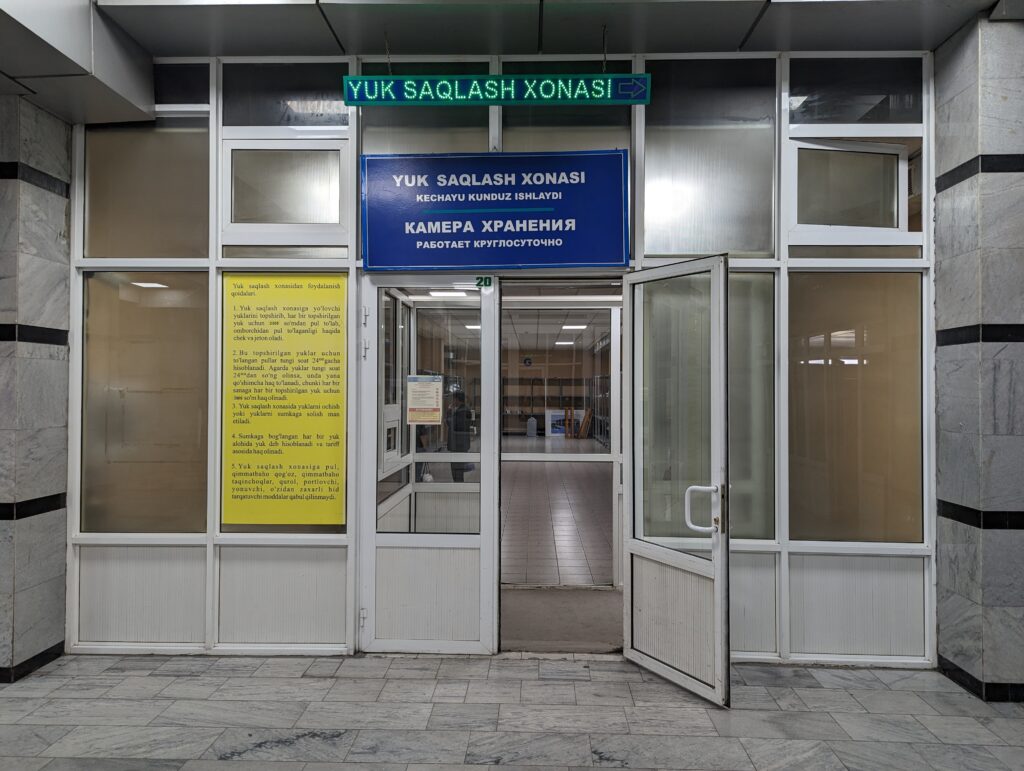
Une fois à la gare, impossible de trouver la consigne pour les bagages. Nous nous trouvions en fait à la gare de bus ! La gare de train est un peu à côté, et l’entrée est très imposante ; au sous-sol, nous trouvons l’endroit où déposer nos sacs. Nous prenons ensuite le métro pour nous rendre au Chorsu bazaar.
Le Métro
Le réseau de métro est suffisamment développé pour nous permettre d’accéder aux principaux points d’intérêts. À chaque station, il y a un guichet et des policiers à l’entrée et sur les quais. J’ai été surpris par la quantité de personnels mobilisés.
Les stations de métro sont toutes différentes et très impressionnantes par leur taille et la richesse des décorations. Nous avons souvent été tentés de descendre du train pour photographier les stations de métro. Une même station porte un nom différent sur chacune des lignes qui la traverse.
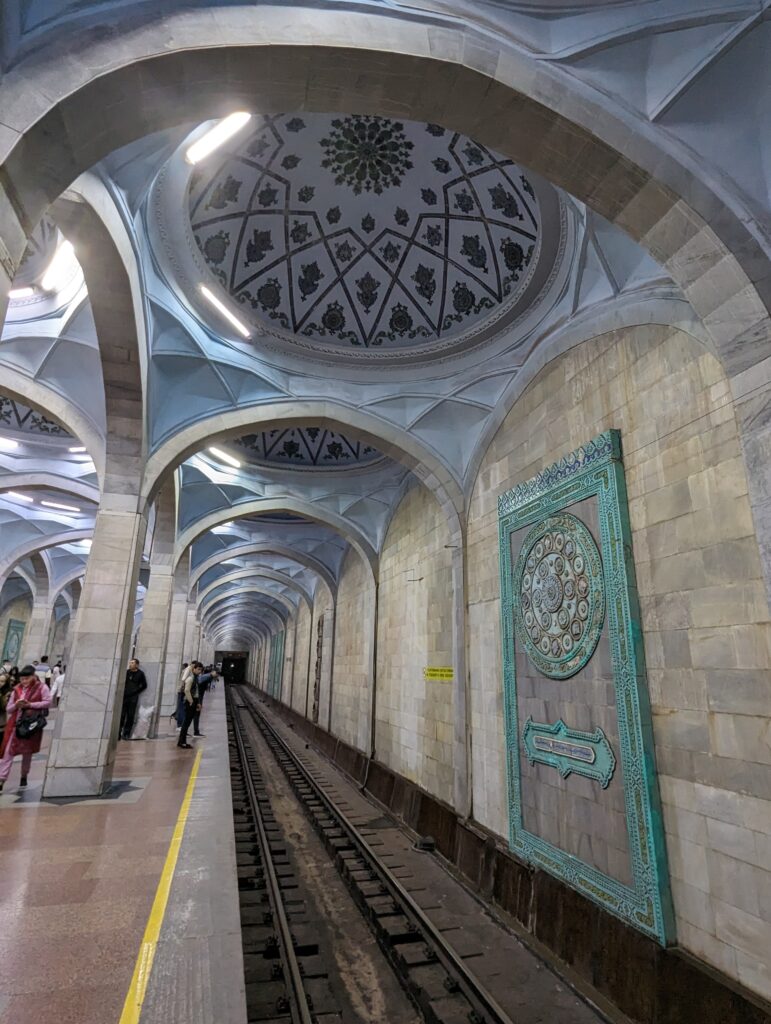
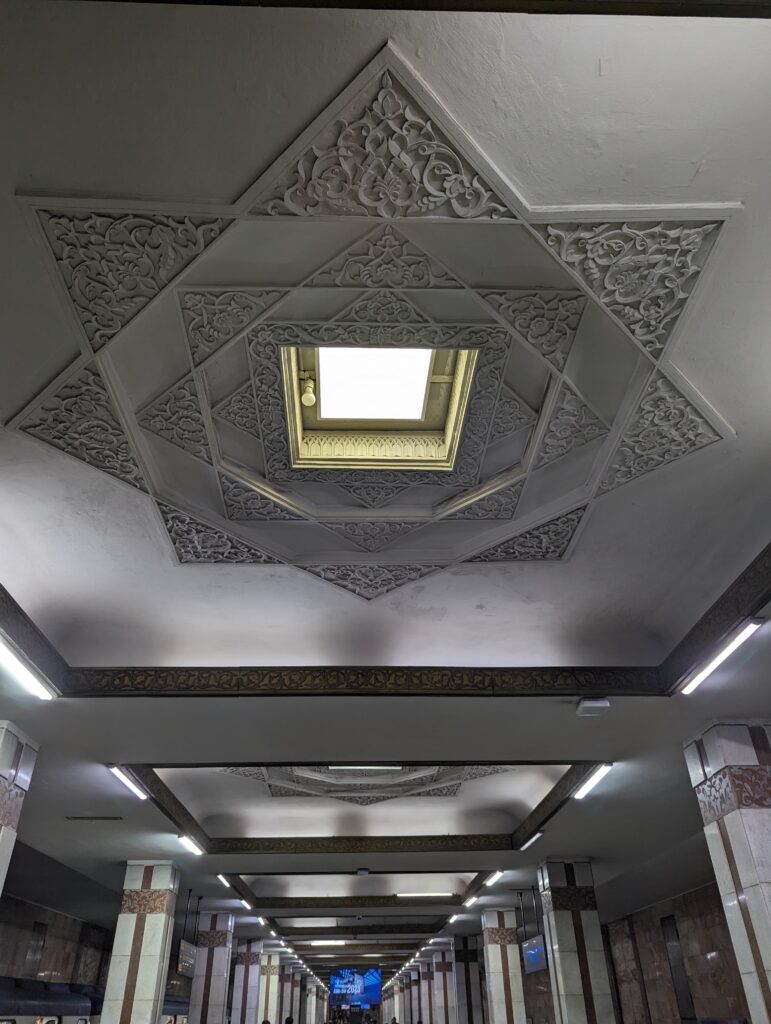
Chorsu bazaar
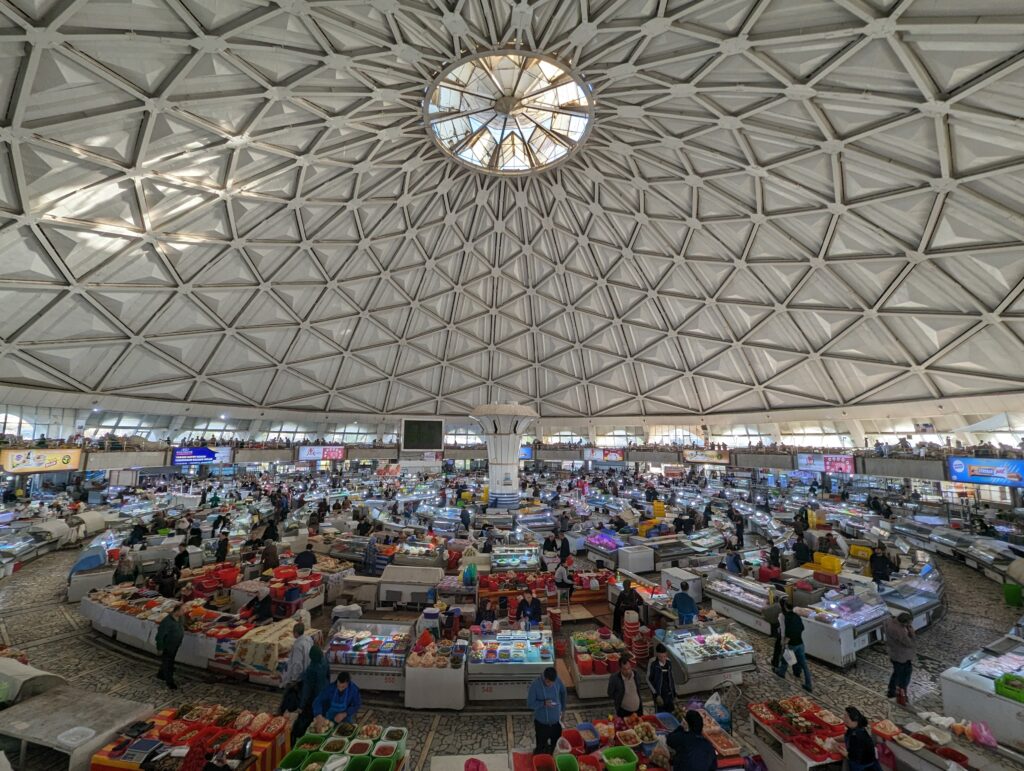
En descendant à la station Chorsu, on arrive au milieu d’un marché. Il nous a fallu un bout de temps pour progresser jusqu’au cœur du Chorsu bazaar. Ce lieu est couvert d’un grand dôme, au rez-de-chaussée, tous ces stands boucherie, de produits laitiers et de produits alimentaires marinés et fermentés, et au premier toutes les noix et les fruits secs.
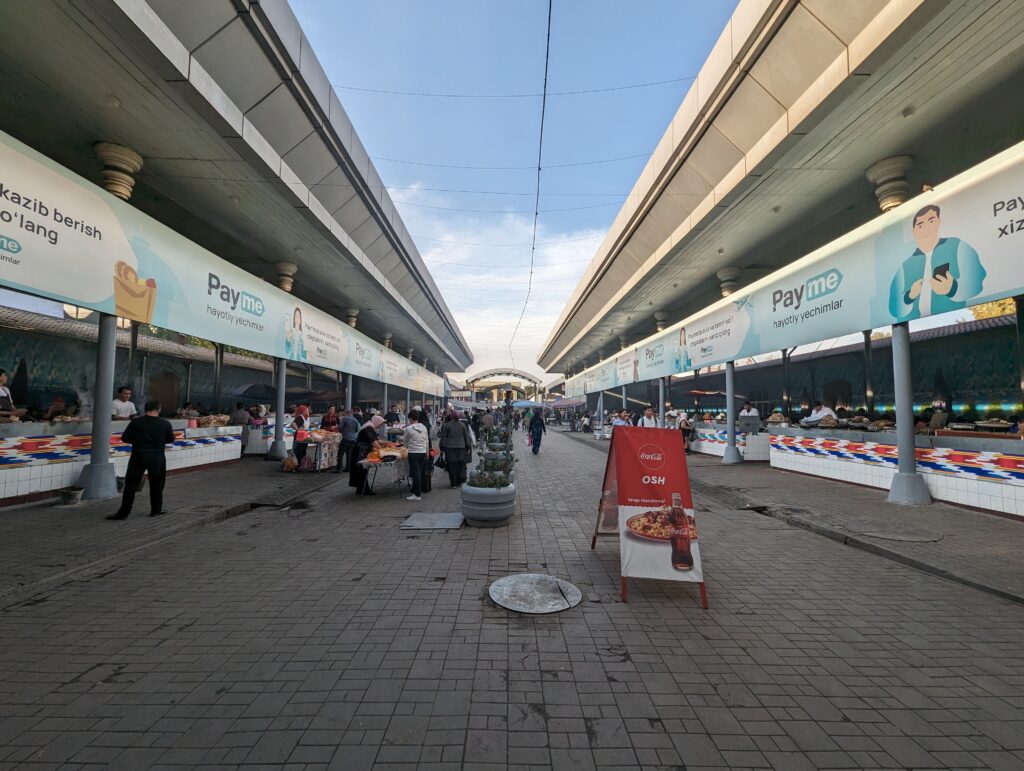
Nous déjeunons dans le food court du marché. Plusieurs stands se mettent ensemble pour proposer un menu assez riche. Nous prenons du plov (le plat national), des brochettes et un feuilleté. On nous dit que le plov vaut 3, en langage des signes. Il s’avère qu’il vaut trente mille et non trois mille. Il y a tellement de zéros dans cette monnaie qu’on ne les mentionne plus, et on se sert du contexte pour en deviner le nombre ! Souvent 000 mais parfois 0 000! Je me régale avec le repas le moins cher que nous aillons fait en Ouzbékistan. En comparaison, les autres repas m’ont paru un peu cher alors que tout était objectivement très abordable.
Nous prenons une bouteille (0.5 L) de jus de grenade pour 15 000 som ou à peine plus d’un euro. Encore une fois, le meilleur prix de tout le voyage en Ouzbékistan.
Nous visitons la Kukeldash Madrasah juste à côté du Chorsu Bazaar. C’est une madrassa tout à fait banale ; nous en profitons quand même, car c’est la première du séjour.
Autour de la place Amir Temur
Nous reprenons le métro et descendons à la station Amir Temur. Amir Temur (Timour ou Tamerlan) est le fondateur de l’immense et éphemère empire timouride, qui avait pour centre l’Ouzbékistan, et dont l’un des descendants, Babur fonde l’empire moghol sur l’Inde actuelle.
Nous prenons une photo de l’hôtel Ouzbékistan. Puis, nous nous promenons dans le parc Amir Temur. Nous descendons la rue Sailgokh qui est piétonne et accueille une sorte de fête foraine. Il y a un grand nombre de tables de tennis de table avec des raquettes et des balles en accès libre et gratuit. Nous en avons bien profité. Les tables étaient dans un superbe état avec des filets proprement ajustés. Les raquettes étaient correctes. Si étonnant pour des tables en libre service!
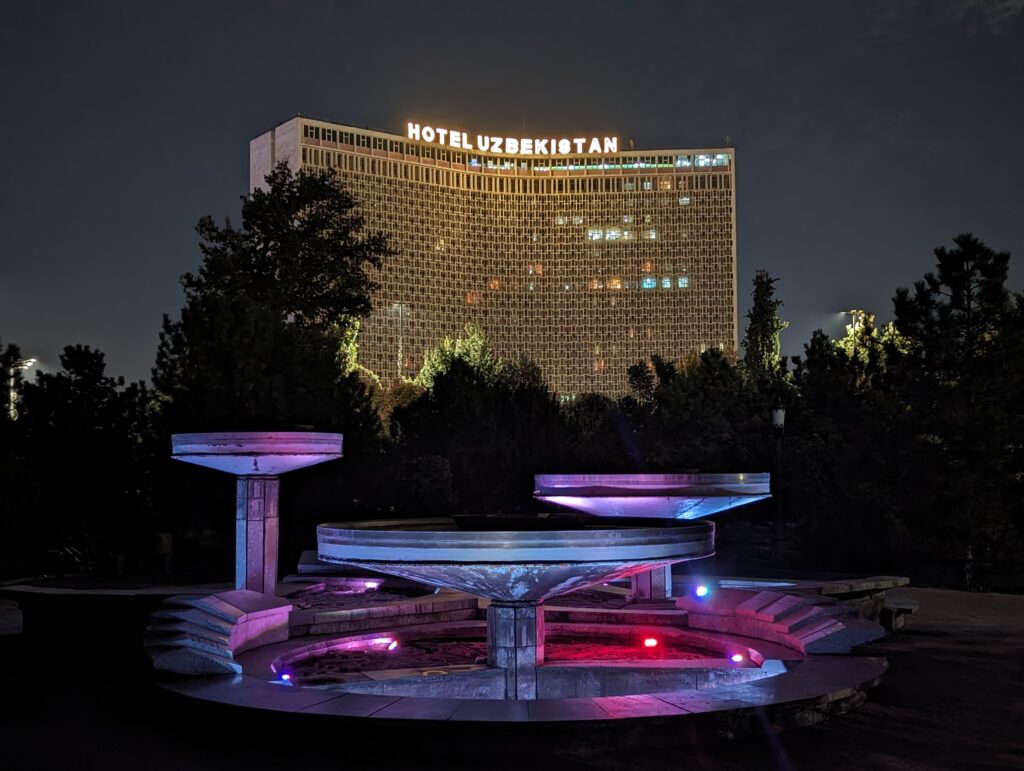
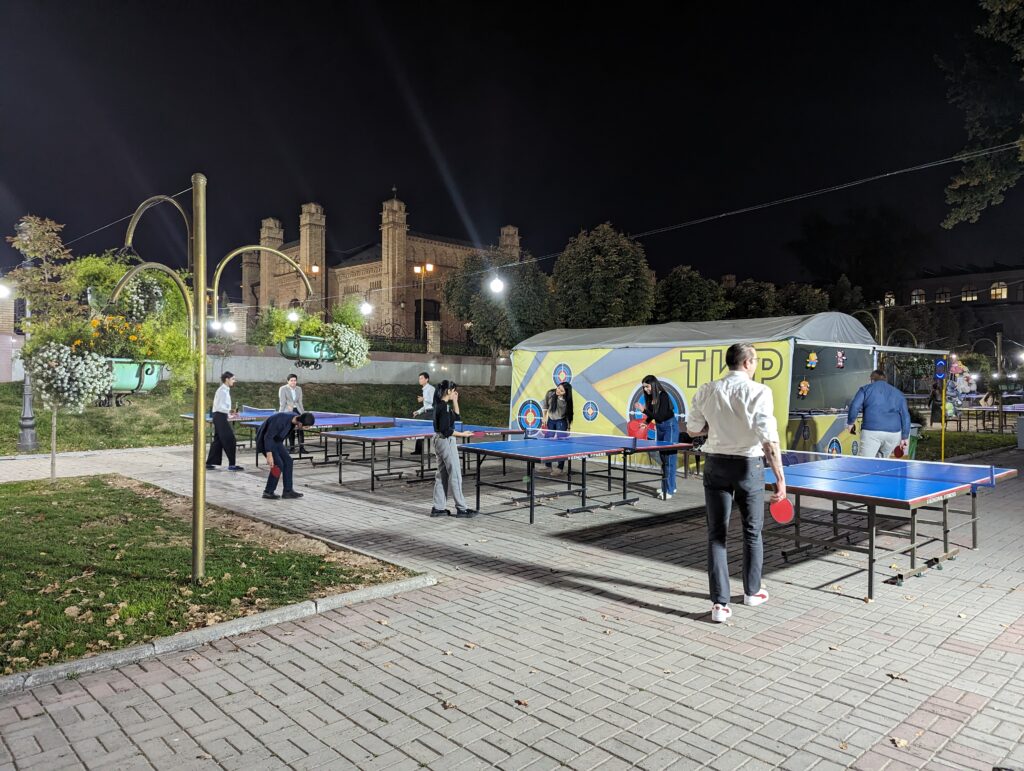
Day 17
The second part of this post about Tashkent is written in English because we spent our last day in Uzbekistan with two Bangladeshi brothers, Mahin and Mishan. We met them during the generous and tasty breakfast at this guest house. We were sitted next to each other. As we saw in Izmir, the breakfast is a very good time to meet people at your accommodation.
Mahin and Mishan are planning to work remotely from many countries in central Asia for 6 months. Uzbekistan was the second foreign country they ever visited. However, they were really comfortable navigating this new territory and talking to strangers.
For Bangladeshi, having multiple countries on your passport help you get an European Union (EU) visa. In Bangladesh, all the expired passports are tied to the valid passport.
State Museum of Applied Arts
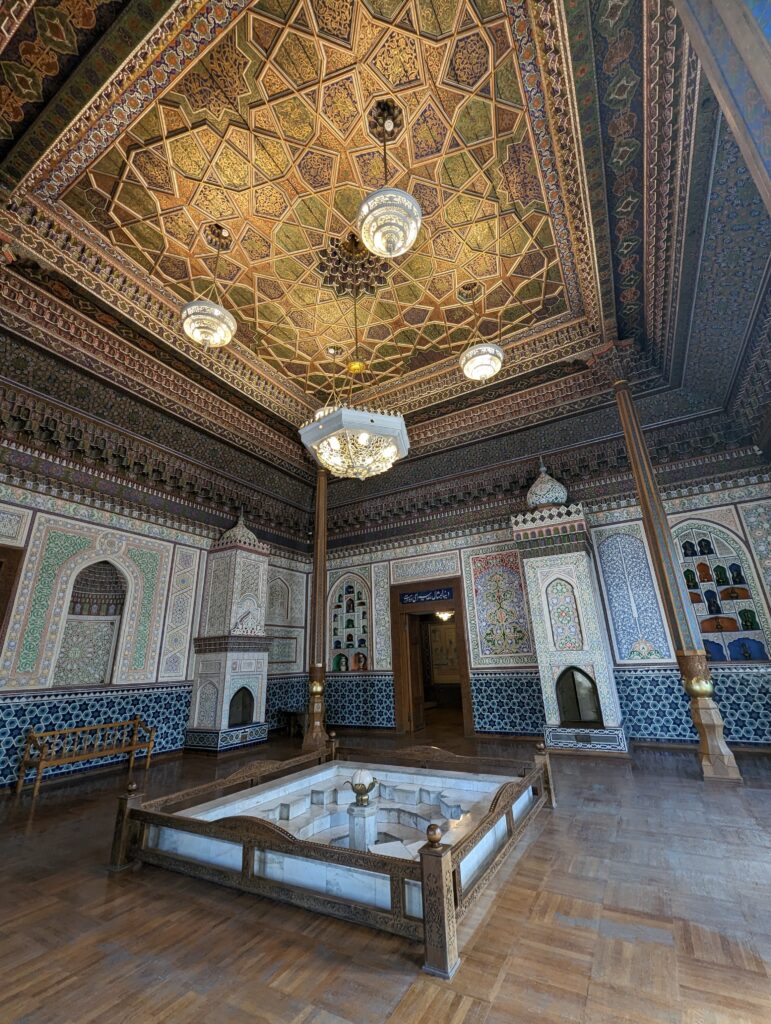
The State Museum of Applied Arts of Uzbekistan is a museum of handicrafts such as textile, embroidery, musical instruments, ceramics, jewelry, gold weaving, miniatures drawings, etc. The museum building, known as the Polovtsev house, has the most beautiful interior I have seen in the country.
It is by far the best museum we have visited in Uzbekistan, that said the bar was pretty low. I forgot the Nukus Museum of Art, which is pretty good as well! It was funny to hear our two friends commenting about how the tapestries, statues and almost every sections in the museum actually were similar to what they have in Bangladesh. We then told them the Temurid history and how this could probably explain why some historical and cultural aspects are shared between Uzbekistan and their country.
The four of us took at taxi to Hazrati Imam Complex.
Hazrati Imam Complex
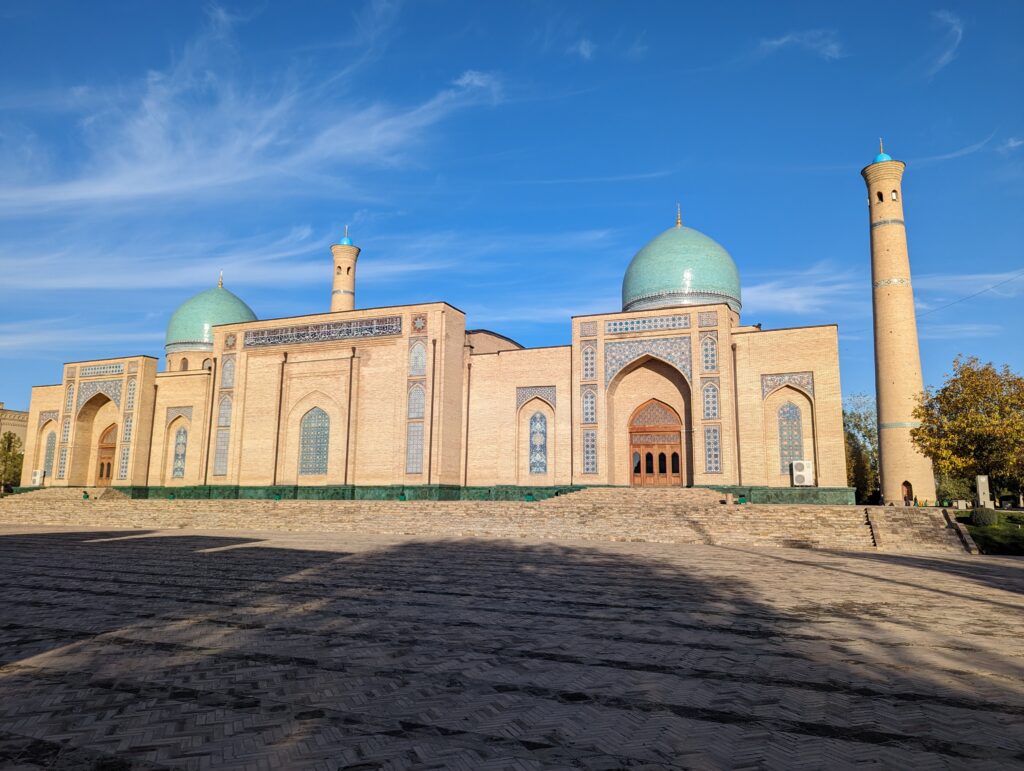
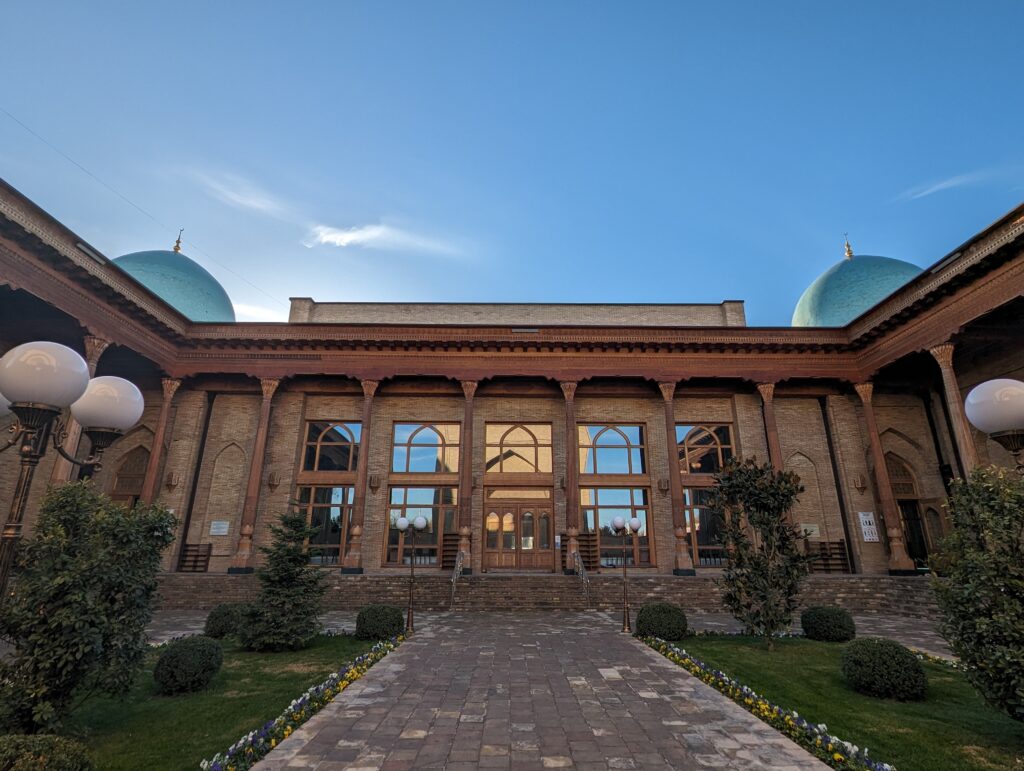
The Hazrati Imam Complex contains some buildings you can visit: a mosque, a madrassa, a shrine, a museum with a collection of Quran. We did not visit the museum. We tried to enter the Imam Al Bukhari Islamic Institute and the Office of Muslims of Uzbekistan without success.
Next to the complex, there is a huge building, called the Islamic Civilization Center, under construction.
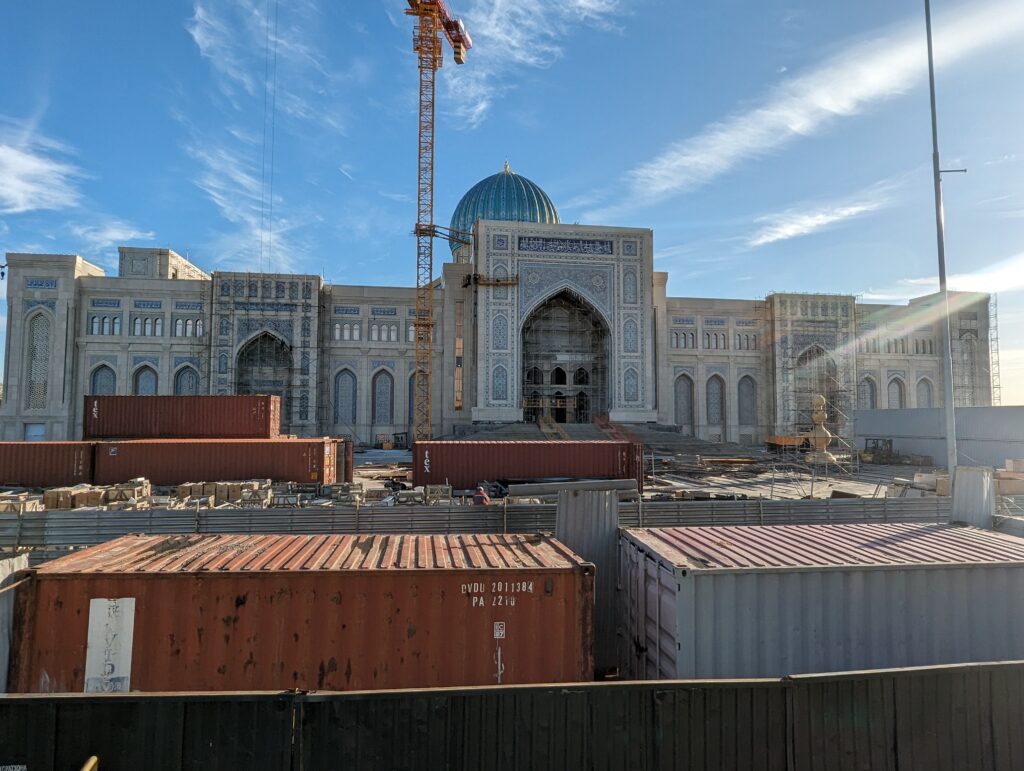
Then we walked to the Chorsu Baazar. We ate at the food court we went to on our 1st day in Uzbekistan. We ordered what we wanted from the stall and sat on the table. Mahin and Mishan then though we ordered for them and we though they ordered their own food by themself on the stall. When we received our food, Mishan was quite surprised we didn’t order for them. I guess it’s some cultural difference, we felt so sorry!
After eating we went under the main dome to buy some nuts. We told our friends its a good idea to buy nuts to share with the people in the trains, as we have been offered many things on our journeys. This is a great way to break the ice! We tried different nuts and everytime we though it was good Mishan though otherwise but Mahin agreed with us. So in the end when Mishan said it was good we couldn’t believe his taste and preferred to ask his brother X). We bought some nuts (the “Uzbek pistachios”) from one of the stores of the main dome. Mishan ate an Uzbek pistachio with the shell when Y told him it was good. I guess they do not really look like pistachios.
We took the metro to Magic city because we wanted to show Mahin and Mishan some beautiful metro stations.
Magic City
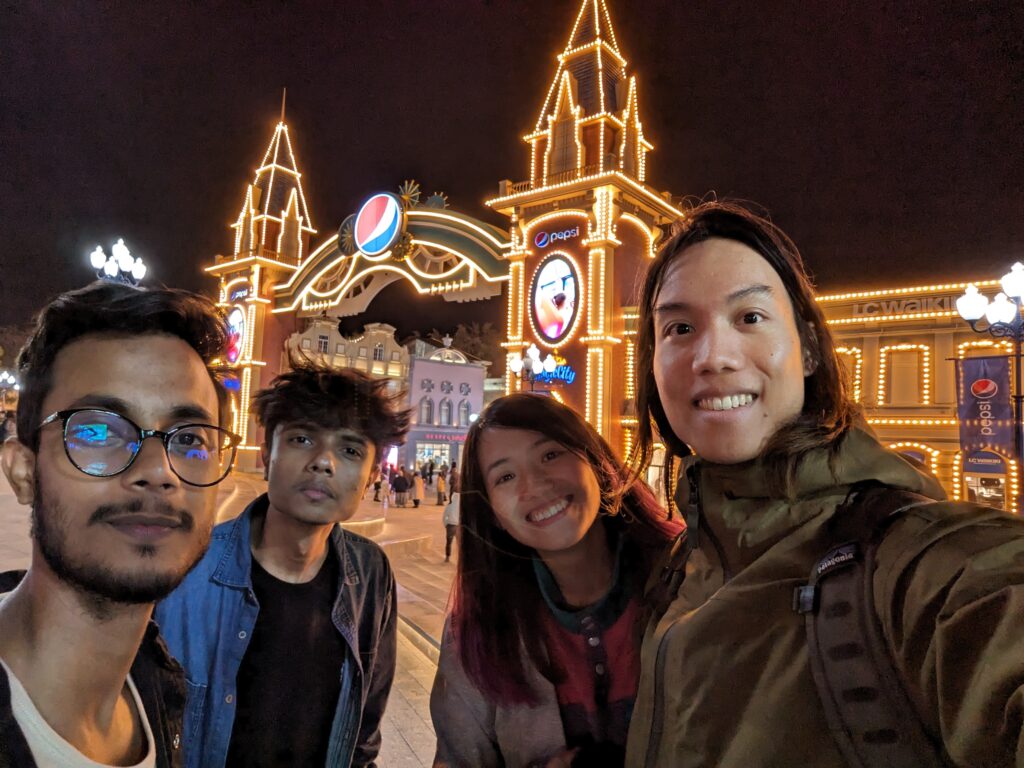
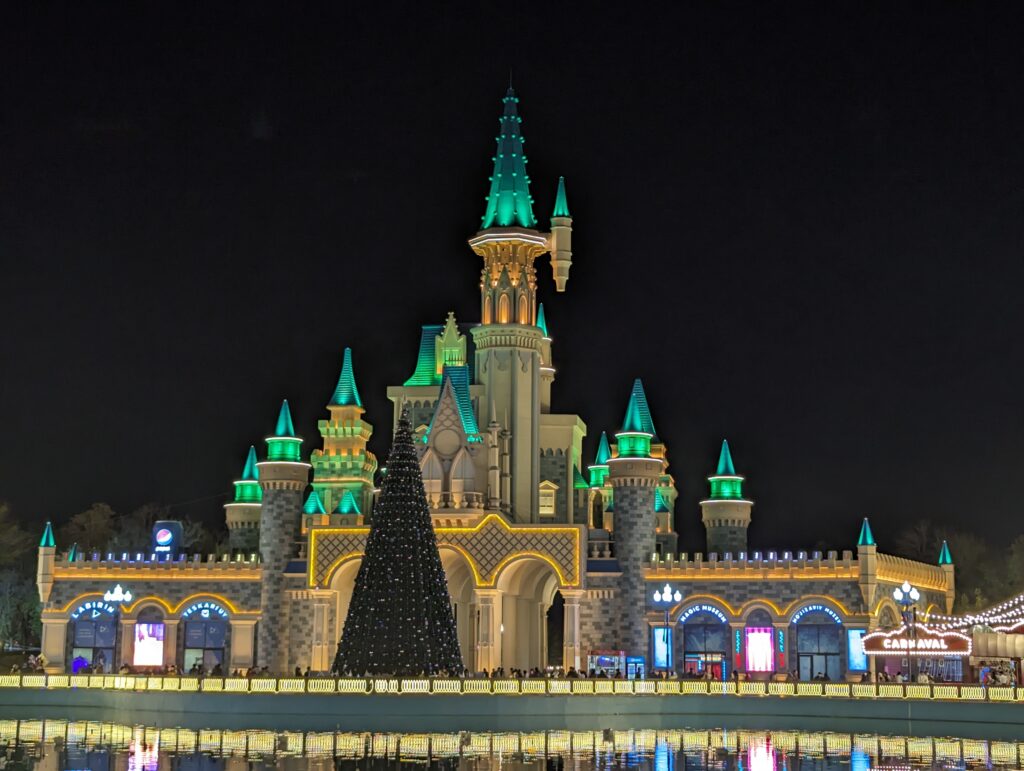
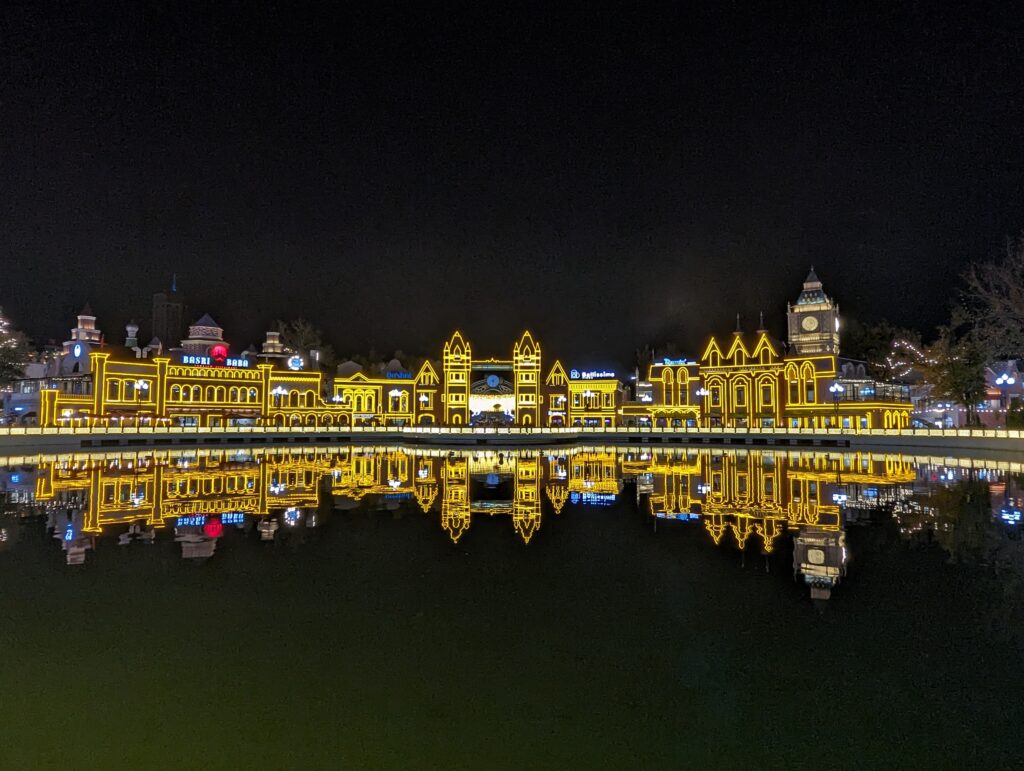
The Mafic City is like Disney Village at Disneyland. Pepsi commercials are everywhere, so we called it Pepsi land. There are many shops and restaurants, a replica of the Registan Square in Samarkand, a fairy tale castle, European style fake houses, lakes, gardens and monuments dedicated to great Uzbek figures.
We helped Mahin and Mishan buy winter coats for their trip in the neighboring countries. It was actually a hard sell since Mishan was very concerned with style. They ended up with very different coats: a down jacket for Mahin and an overcoat for Mishan. We missed a big part of the concert on the fake Registan Square, but it was a really nice concert and we had a great time there! We realized Uzbek never clap.
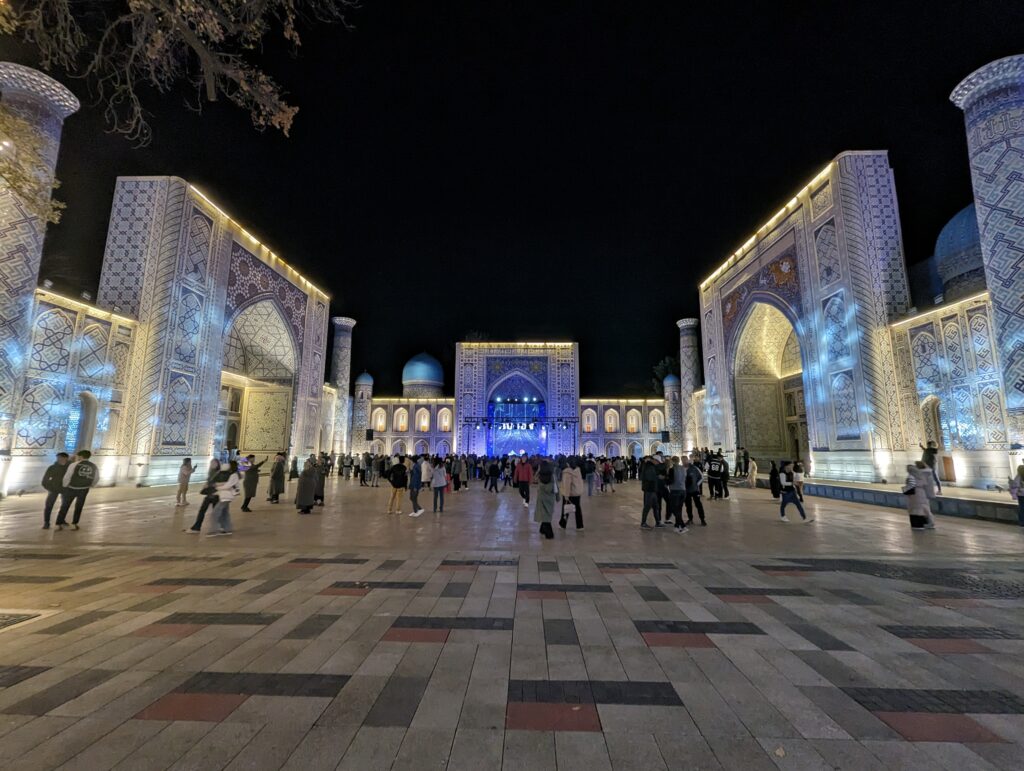
We had some KFC, where we finished all of our cash. It was the only place, operated by an international brand, we have been to during our whole stay in Uzbekistan.
While we where walking along the lakes of Magic City, we stopped at the at foot of a small hill where a big statue was standing. We asked a group of guys, who were sitting there, what it was. We grasped it was the statue of Alisher Navoy. They proposed to walk us there. And then, they also walked us to the statues of the national heros in the park, providing information we could barely understand sometimes. They were law students. Many of them were not from Tashkent and were talking to foreigners for the first time. They were super friendly!
We said goodbye after a vodka and coke, the vodka we had bought earlier in Khiva. It was actually Mahin and Mishan’s first time trying Vodka (and 3rd time drinking for Mahin).
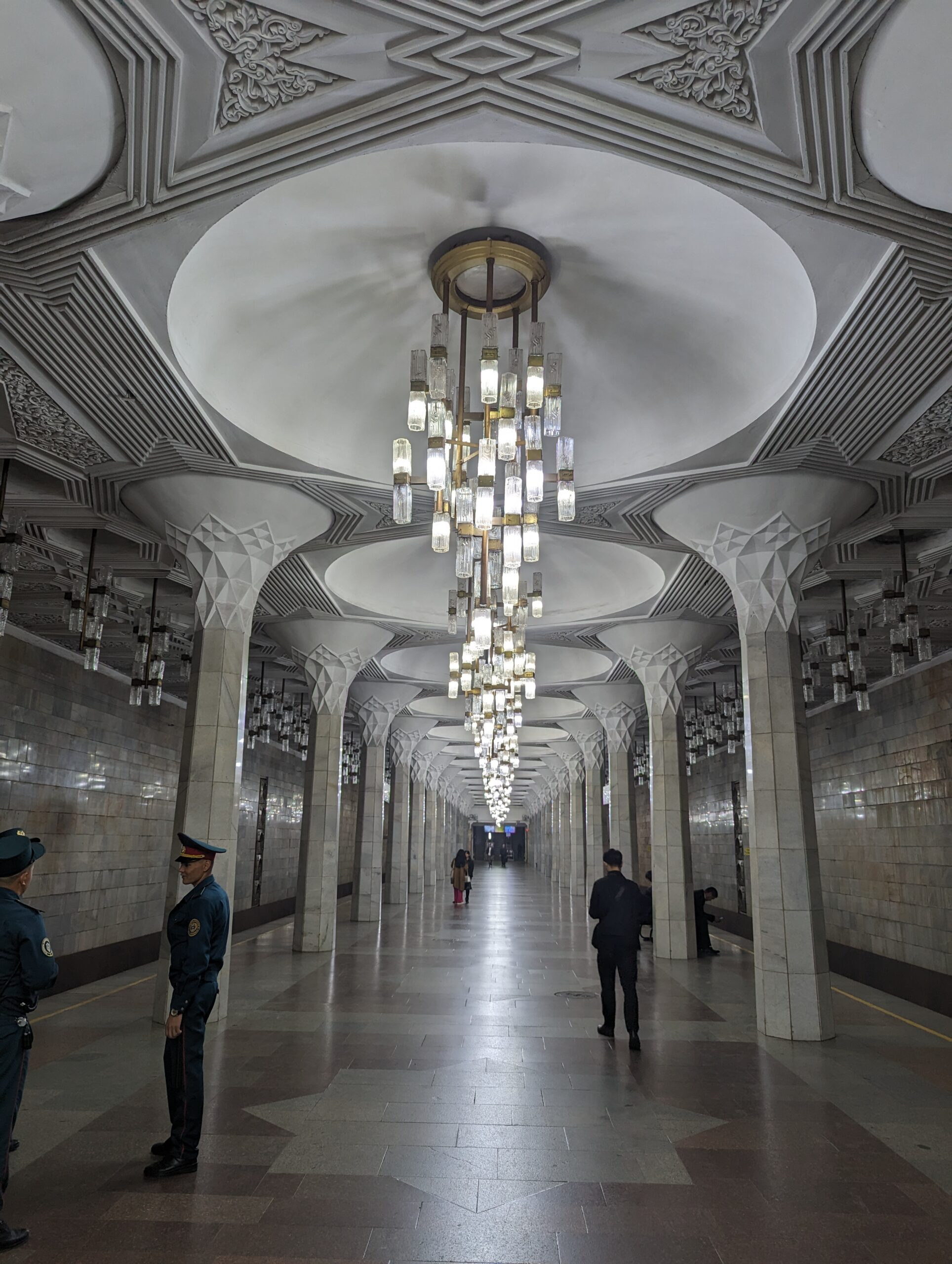
Leave a Reply